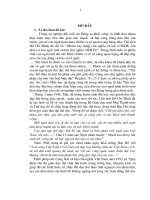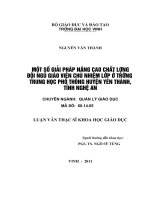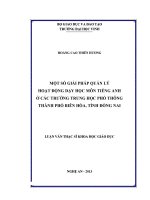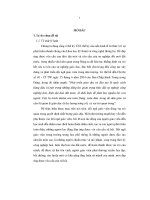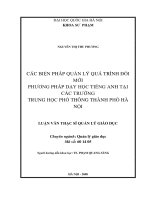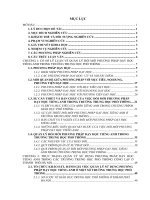Luận văn sử dụng phương pháp phỏng vấn nghiên cứu về động lực phát triển chuyên môn của giáo viên tiếng anh tại một trường trung học phổ thông
Bạn đang xem bản rút gọn của tài liệu. Xem và tải ngay bản đầy đủ của tài liệu tại đây (257.58 KB, 46 trang )
ABSTRACT
The study deals with the theories of the motivation for EFL teachers in
participation in PD. It is important that it is carried out to investigate the case
of EFL teachers at HaiAn high school.
The researcher uses the methods such as interviewing closely EFL
teachers to understand their attitude to professional development, and the
participants all have positive attitude toward PD. At the same time, the
researcher studies the professional development activities that EFL teachers
participate. In accordance with the theory mentioned in chapter one, the EFL
teachers all take part in the same formal and informal PD activities, especially
the reflective practice. Also, the participants are asked to talk about their
opportunities and challenges for their professional development.
The result shows that the EFL teachers have strong motivation for PD,
although they have some certain obstacles in participation in this process.
The study also gives suggestions of measures to overcome difficulties
when taking part in professional development.
i
TABLE OF CONTENTS
ABSTRACT..................................................................................................................i
2. Aims of the study...........................................................................................................2
3. Scope of the study..........................................................................................................3
4. Research questions.........................................................................................................3
5. Methods of the study......................................................................................................3
6. Overview of the study....................................................................................................3
II . DEFINITION OF TERMINOLOGIES........................................................................4
2. 2. Professional development...........................................................................................5
3. 2. Why do new educators need extra support?.............................................................10
PART B: DEVELOPMENT......................................................................................16
CHAPTER II: RESEARCH METHODOLOGY......................................................16
2. 1 The setting of the study.............................................................................................16
2.2 Participants.................................................................................................................16
CHAPTER III: FINDINGS AND DISCUSSION.....................................................19
2.1. Teachers’ perceptions of the importance of PD........................................................19
2.2.Teachers’ self-reported PD activities they often participated in............................20
2.3.Teachers’ self-reports on the opportunities and challenges for their PD...............25
4. Summary of the chapter...............................................................................................30
PART C: CONCLUSION..........................................................................................32
CHAPTER IV: CONCLUSION................................................................................32
REFERENCE.............................................................................................................37
APPENDIX 1................................................................................................................I
1. According to you, how is professional development important for teachers?............I
ii
2. According to him (her), there are other forms of professional development for
teachers?..........................................................................................................................I
3. Do you regularly attend professional training courses or not? Why do you attend
such training courses?.....................................................................................................I
4. In addition to teacher training courses, which form of training do you self-study to
improve your pedagogy?Why do you use those activities?............................................I
5. Do you often attend your colleagues’lessons or not? Why and Why not? If yes, do
you learn anything through your fellows’ classes?........................................................II
6. Do you often think of the lessons you’ve taught? Why and why not? Did you learn
something after thinking of your previous lessons again?.............................................II
7. Do you often read professional books? If so, why? What kind of books do you
often read? Why do you often read those kinds of books?............................................II
8. Have you ever conducted research on students or improved your teaching
hours? Why and why not? If so, how often? Please give an example?.........................II
9. Do you have any advantages and disadvantages of improving your professionals?. II
iii
PART A: INTRODUCTION
Chapter I : LITERATURE REVIEW
I.
INTRODUCTION
1. Rationale
Everyone is continually developing as a person and, every day in the
workplace, we are always learning. Tomorrow will be different from today
and we all need to be prepared for change. Whether you think your role is
changing or not, you need to be prepared for the next development
opportunity so you don’t miss out.
Professional development has become a major focus in EFL teacher
education programs worldwide since it is undoubtedly beneficial and essential
for professional growth and more effective teaching. In the paper presented at
the first General Teaching Council for Northern Ireland Annual Lecture in
Belfast in March 2006, Geoff Whitty for Institute of Education, University of
London states that: Contemporary education reform – including marketisation
and centralization, but also a new emphasis on the involvement of a wider
range of stakeholders – has resulted in a period of significant change for
teachers. It has also raised for new questions: for example, what is teacher
professional development? How should we understand the roles of teachers?
What professional development activities are available and accessible to
teachers, and what are the factors affecting teacher’s participation in those
professional development activities? The purpose of this thesis isthus to
refocus on our attention on teachers’ views, especially on urgency of
providing teacher professional development that change teachers behaviours
in ways that lead to improvement in students’ performance. In addition to
calling attention
to the ongoing need for effective teacher professional
development, I will describe characteristics of high quality professional
development and make a case for an unconventional approach to professional
1
development that, unlike “one-shot” workshop and inservice days, allow
teacher to acquire and practice new skills over time.
While the end result of all education reform should be student
improvement, every reform initiative, if it is to succeed, must begin with
recognition of the importance of teachers in raising student performance
(Ferguson, 1991; Armour-Thomas, Clay, Domanico, Bruno, & Allen, 1989).
In other words, “student achievement is the product of formal study by
educators” (Joyce and Showers, 2002, p.3). We cannot expect students to
change what they do if we are content for teachers to continue doing what
they have always done. As an old adage puts it, “If you do what you’ve
always done, you will get the results you’ve always gotten.”
This thesis firstly presents the theoretical issues about the roles and
nature of EFL teachers in professional development. Chapter I – Introduction.
To clarify these issues, the definition of terminologies is mentioned in chapter
II. The next chapter is the presentation of the objectives, aims, methodology
used for the research and its findings. The conclusion which includes some
comments and recommendations is presented in chapter IV.
In consideration of these problems, as an English teacher, I really want
to clarify the topic here with my knowledge and my supervisor’s guidance to
analyze, understand the situation of teaching and learning English at HaiAn
high school. Thanks to it, I will find out lessons, experience for myself and
make a small contribution to enhancing the effectiveness in teaching this
subject.
2. Aims of the study
The major aims of the study are:
- to gain understandings of secondary school teachers’ motivation for
professional development; and define what is meant by motivation.
2
- to discuss some common professional development activities.
- to identify factors that affect either positively and negatively teachers’
motivation for professional development.
3. Scope of the study
Given the rationale and the aims of the study, it is necessary to limit the
study to the areas which are manageable. Benefits of teacher professional
development create the effectiveness of students’ learning which focuses on
two factors: developing teachers’ motivation in participation in PD and
factors affecting this process. The subjects under the study are at HaiAn High
School.
4. Research questions
The study attempts to find the answers to the following research
questions:
- What are EFL teachers’ attitudes to professional development?
- How motivated are they for professional development?
-What are the common professional development activities secondary
school teachers participate in?
- What factors that affect teachers’ motivation for
professional
development in the secondary school context ?
5. Methods of the study
Because the primary purpose of this study is to gain understanding of the
phenomenon under investigation, the main methodology used is qualitative.
Specifically, data for this study were merely obtained by means of face-toface interviews.
6. Overview of the study
The study is organized around three parts:
3
Part I – Introduction – provides the rationale for the study and sets up
the aims, scope, research questions and methods of the study.
Part II – Development – consists of three chapters:
- Chapter 1: Literature review_ is concerned with the literature review
of the study.
- Chapter 2: Methodology _ describes the study population, the
research design as well as data gathering instruments.
- Chapter 3: Results and discussion _ analyses and discusses data.
- Chapter 4: Findings and implications_ presents findings and
implications. Limitations and suggestions for further research are also
provided.
Part III – Conclusion – summarizes and makes a conclusion to the main
points which have been explored in the study, gives out recommendations to
develop the effectiveness of teacher professional development, some
suggestions for future research and the limitation of the study.
II .
DEFINITION OF TERMINOLOGIES
2. 1. What is motivation?
Each individual theory tends to be rather limited in scope. However, by
looking at the key ideas below, you can gain a better understanding of
motivation as a whole.
According to http//. Psychology.about.com,
Motivation is the force that
initiates, guides and maintains goal-oriented behaviors. It is what causes us to
take action, whether to grab a snack to reduce hunger or enroll in college to
earn a degree. The forces that lie beneath motivation can be biological, social,
emotional or cognitive in nature.
4
In everyday usage, the term motivation is frequently used to describe why a
person does something. For example, you might say that a student is so
motivated to get into a clinical psychology program that she spends every
night studying. (http//. Psychology.about.com)
Components of Motivation
There are three major components to motivation: activation, persistence and
intensity. Activation involves the decision to initiate a behavior, such as
enrolling in a psychology class. Persistence is the continued effort toward a
goal even though obstacles may exist, such as taking more psychology
courses in order to earn a degree although it requires a significant investment
of time, energy and resources. Finally, intensity can be seen in the
concentration and vigor that goes into pursuing a goal. For example, one
student might coast by without much effort, while another student will study
regularly, participate in discussions and take advantage of research
opportunities outside of class.
2. 2. Professional development
In workplaces, professional development refers to the acquisition of
skills and knowledge both for personal development and for career
advancement. Professional development encompasses all types of facilitated
learning opportunities, ranging from college degrees to formal coursework,
conferences and informal learning opportunities situated in practice. It has
been described as intensive and collaborative, ideally incorporating an
evaluative stage. - cite_note1 There are a variety of approaches to professional development, including
consultation, coaching, communities of practice, lesson study, mentoring,
reflective supervision and technical assistance.
5
Professional development is a broad term, encompassing a range of people,
interests and approaches. Those who engage in professional development
share a common purpose of enhancing their ability to do their work. At the
heart of professional development is the individual's interest in lifelong
learning and increasing their own skills and knowledge.
Teacher professional development
Professional development is defined as “the process of improving staff
skills and competencies needed to produce outstanding educational results for
students” (Hassel, 1999).
The “professional” in professional development implies expertise, pursuit
of advanced training, and maintenance of currency in an evoking knowledge
base. (Four &Eaker, 1998)
Teacher professional development is the process of teaching teachers new
strategies to improve the quality of instruction.
Student achievement is linked to numerous factors, but quality teachers are
one of the most important components of students’ success. If a school
district’s teachers do not have the tools they need to teach students
effectively, their students will suffer. To teacher effectively, teachers need
access to ongoing teacher professional development. This professional
development enables teachers to improve their own education through
seminars, workshops, and classes.
Through teacher professional development, teachers learn new teaching
strategies to improve the quality of instruction. This allows them to make
changes in the way they teach their students, incorporating innovative
teaching methods in the classroom. It teaches them how to work with a
variety of learning styles, since not all students learn the same way. It also
6
helps teachers change their day-to-day teaching methods, encouraging them to
accept new methods based on accurate education research.
Professional development usually takes place when school is not in
session. Most teacher professional development occurs in the evening, on
weekends,
or
during
the
summer.
School
districts
also
schedule professional development days throughout the school year. During
these days, students are dismissed early from school or have a day off from
school. This provides teachers, teaching assistants, and administrative staff
the opportunity to participant in training and workshops.
Teacher professional development is sometimes criticized because it
sometimes does not provide teachers with the time, information, and activities
they need to make changes within the classroom. For this reason,
some professional development involves training throughout the school year.
Mentors and coaches who are considered experts in new teaching methods
and
strategies
meet
with
teachers
during
classroom
instruction
or teacher planning time. This can help teachers use what they have learned in
a real-world setting, building a bridge between new concepts and classroom
instruction.
Effective teacher professional development is designed to strengthen
teachers’ knowledge of content. It is based on research and provides data that
such new teaching methods culminate in improved student achievement.
Teacher professional development should also closely align with a particular
state’s standards and the curriculum used by the school district.
Professional development should ideally be created by teachers with the
support of those who work in the field of education research.
All professional development should provide teachers with the necessary
resources and support to implement changes in teaching strategies.
7
Finally, professional development should provide teachers with the time they
need to understand the new teaching methods and incorporate them in their
teaching.
In short, the professional development process can be illustrated by the
three track circle below.
III.
WHY IS PROFESSIONAL DEVELOPMENT IMPORTANT?
On the website www.learningforward.org, Stephanie Hirsh indicates that
professional development refers to many types of educational experiences
8
related to an individual’s work. Doctors, lawyers, educators, accountants,
engineers, and people in a wide variety of professions and businesses
participate in professional development to learn and apply new knowledge
and skills that will improve their performance on the job.
Many fields require members to participate in ongoing learning approved
by
the profession, sometimes as a requirement for keeping their jobs.
Professionals often also voluntarily seek new learning.
In education, research has shown that teaching quality and school
leadership are the most important factors in raising student achievement. For
teachers and school and district leaders to be as effective as possible, they
continually expand their knowledge and skills to implement the best
educational practices. Educators learn to help students learn at the highest
levels.As Thomas Guskey (2000, p4) states, “One constant finding in the
research literature is that notable improvements in education almost never
take place in the absence of professional development.” PD is key to meeting
today’s educational demands.
Many people may not be aware of their local school system’s methods for
improving teaching and student learning. Professional development is the
only strategy school systems have to strengthen educators’ performance
levels. Professional development is also the only way educators can learn so
that they are able to better their performance and raise student achievement.
3. 1. Why do educators need professional development? Did they
learn what they need to know in college?
College and university programs cannot provide the extensive range of
learning experiences necessary for graduates to become effective public
9
school educators. Once students graduate, meet their state’s certification
requirements, and are employed, they learn through experience. As in all
professions, new teachers and principals take years to gain the skills they need
to be effective in their roles. The complexity of teaching is so great that onethird of teachers leave the profession within three years (Ingersoll, 2003).
Even experienced teachers confront great challenges each year, including
changes in subject content, new instructional methods, and student learning
needs. Educators who do not experience effective professional development
do not improve their skills, and student learning suffers.
In short, professional development provides ongoing opportunities for
educators to continue to improve their knowledge and skills so they can help
students achieve. When educators learn, students learn more. Anyone
concerned about students’ futures will want to support a cycle of continuous
professional development.(Professional development.A Proccess. Not an
event.)
3. 2. Why do new educators need extra support?
New teachers juggle an overwhelming number of unfamiliar issues, such
as classroom management, instruction, curriculum, school culture and
operations, test preparation and administration, state standards, parent
relations, and interaction with other teachers. Left to themselves, they may
develop counterproductive behaviors. With extra support, however, new
teachers learn more effective practices to apply to daily challenges.
Additional support also helps district retain new teachers and set them on the
path to becoming effective educators. Many school systems provide mentors
and induction programs for novice teachers. These programs are required in
many states for teachers to earn a professional license. Most importantly,
10
research shows that new teachers who received intensive mentoring had a
significant effect on student achievement after as little as two years (Strong,
Fletcher, &Villar, 2004; Serpell& Bozeman, 1999)
IV.
PROFESSIONAL DEVELOPMENT ACTIVITIES
As PD varies from different educational traditions and contexts.
Teachers’ PD, in a general term, means teacher learning in an ongoing way.
PD implies the improvement of the school as well as the professional
advancement of individuals; in other words, PD can embrace personal
development (individualized learning) and staff development (the collegiality
of group learning/ co-learning) ‘ (Bell, 1991a)’. On this point, Day (1999)
gives a similar but useful definition about professional development, stating
that: professional development consists of all natural learning experiences and
those conscious and planned activities which are intended to be of direct or
indirect benefit to the individual, group or school and which contribute to the
quality of education in the classroom (Day, 1999:4)
Thus professional development encompasses all activities that cater
both for the individual needs of teachers and for the institutional needs of the
whole school (Bell, 1991). The teacher, the school and the students thus
benefit from such a process of professional development (Bell, 1991)
Due to changing demands on the new roles of teachers in the 21 st
century, traditional approaches to PD such as formal courses or one-off
seminar are criticized for their shortcomings of being unable to get teachers
prepared for the new role of knowledge facilitator rather than knowledge
transmitter (e.g. Darling-Hammond, 1998: Lieberman, 1996). Instead, two
theoretical perspectives lead the alternative approaches to PD which support
11
teachers learn more effectively (Kwakman, 2003). These two perspectives
include cognitive psychological and professional development perspective.
Cognitive psychological Perspective
Student learning and teaching are the same from cognitive psychological
perspective (Borko and Putnam, 1996; Putnam and Borko, 2000). Teachers
are assumed to learn like what students do in which teachers are considered as
constructors of knowledge who learn actively in a self-directed way. Such
kind of learning occurs when interacting with the learning context and it is
strongly affected by prior knowledge individual earner (Borko and Putnam,
1996). In other words, this kind of learning is situated and influenced by the
interplay of the individual’s existing knowledge and the learning
environments. Thus, teacher learning takes place when favorable learning
environments are provided in which teachers are responsible for their own
learning (Bransford, Brown and Cocking, 1999) whereas staff developers play
an important role in creating favorable learning environments for teacher
learning.
Professional development perspective
Instead of emphasizing the provision of favorable environments for enhancing
teacher learning, from professional development perspective, it stresses that
teachers have to learn how to teach for understanding where they ought to
learn new conceptions of content and pedagogy and take on new roles
(McLaughlin, 1997). Hence, the working context is understood to be the best
place for teachers to acquire competencies that they need to fulfill their new
roles through practice (Hargreaves, 1997; Kwakman, 2003; Retalick, 1999).
The working context for teachers can be the daily teaching context, including
classrooms, school clusters, and other forms of communities such as
12
partnership with universities, networks, etc. In other words, teacher learning
occurs at the workplace in which their learning is situated and closely aligned
with teachers’ work in classrooms and schools (Garet, Porter, Desimone,
Birman, and Yoon, 2001; Huffman, Thomas, and Lawrenz, 2003; Sparks and
Loucks-Horsley, 1989), and it can be at individual level and collaboration
level (Kwakman, 2003).
In conclusion, according to the “Why does professional development
matter, issued 2005” teacher PD activities are grouped into these typical
models below.
- Individual reading / study / research.
- Study groups among peers focused on a shared need or topic.
- Observation: teachers observing other teachers.
- Coaching: an expert teacher coaching one or two colleagues.
- Mentoring of new educators by experienced colleagues.
- Team meeting to plan lessons, problem solve, improve performances,
and/ or learn new strategy.
- Faculty / grade- level or departmental meetings.
- Online courses.
- College, university courses.
- Workshop to dig deeper into a subject.
- Conference to learn from a variety of experts through the country/ area/
world.
- Whole – school improvement programme.
- Proprietary programme by private venders.
V.
FACTORS AFFECTING TEACHERS’ PARTICIPATION IN
PROFESSIONAL DEVELOPMENT.
13
Few studies were conducted to examine factors affecting teachers’
participation in PD activities over the decade in different countries. Kwakman
(2003) conducted an empirical study about a number of factors affecting
teachers’ participation in PD in the Netherlands. In her study, three factors,
personal factors
(i.e. professional attitudes, appraisals of feasibility,
appraisals of meaningfulness, emotion exhaustion, loss of personal
accomplishment), and task factors (i.e. pressure of work, emotional demands,
job variety, autonomy, participation) and work environment factors (i.e.
management support, collegial support, intentional learning support) were
used to examine the effects on teachers’ participation in PD. As a result, of
these three factors, personal factor seem to be more significant in predicting
teachers’ participation in PD activities
than task and work environment
factors. However, this study may over-generalize the factors may be
understated (e.g. family factor) and not context-specific to other situations or
cultures.
Another study conducted by Lee (2002) identified a number of factors
facilitating and inhibiting effective professional development, ‘ relevant/
realistic content’ was the most important factors were ‘ presenter with recent
experience’ (9%) and ‘ based on practice’ (9%). The details of the results are
listed in Table 1. He also examined factors inhibiting effective professional
development. The most commonly cited factor that inhibits effective
professional development was ‘insufficient resources to implement learning’
(21%), whilst the least frequently cited factor was ‘ school not supportive of
PD’ (13%) (see Table 2). Some other factors related to PD providers,
including contents, formats, and presentation of PD activities, should be
considered in affecting teachers’ participation in PD activities, and they
should be supplementary to the factors in Kwakman’s(2003) study as
14
mentioned above.To sum up, the above studies examined a number of factors
that affect teachers’ participation in PD activities. This study takes an
exploratory approach to further explore the factors affecting teachers’
participating in PD in Hai An high school context.
15
PART B: DEVELOPMENT
CHAPTER II: RESEARCH METHODOLOGY
2. 1 The setting of the study
Hai An
high school is one of the newly-established schools in
HaiPhong city. It has a history of only 7 years of foundation. In spite of the
young age, it is famous for its efforts of good teaching and learning with the
students getting many prizes in the exams of HaiPhong city every year. The
material conditions of the school are well-equipped, which also helps to create
its success. However, most of students are good at and like learning natural
science subjects. The school is trying to look for methods so that students are
good at both natural subjects and social ones, especially English.
2.2 Participants
There are 8 teachers of English, including the researcher, aged from 29
to 34. All of them graduated from universities. The number of female teachers
formed the majority (7 female teachers and 1 male teacher). All of them are
enthusiastic with their careers and have at least 5 years of experience in
teaching English.
This case research involves only 6 teachers from the group of English, HaiAn
high school. These participants are chosen on a voluntary basis of the
professional development. When the researcher presented her research
proposal and called for participation, six teachers volunteered to take part in
the study and one afternoon per week we have an informal meeting to
exchange ideas about the research area.
2. Data collection instruments
Study on teacher learning to improve their professional development is to do
a research of a complex phenominence in teacher activities: what knowledge
16
about the areas the teachers have, and how they gain the knowledge. This
involves both individualand social issues, which are both short- term and
long- term. Thus, while doing the research, the researcher is aware that no
methodology is perfect.In this study interviewing was used as the sole
instrument of data collection.
2.1. Interviews
Frey and Oishi (1995:01) define a research interviewas "a purposeful
conversation in which one person asks prepared questions (interviewer) and
another answers them (respondent)" This is done to gain information on a
particular topic or a particular area to be researched. Interviews are a useful
tool which can lead to further research using other methodologies such as
observation and experiments (Jensen and Jankowski 1991:101). Interviews
can have one of two basic structures. They can be either structured (closed
interview style) or unstructured (open interview style). Open-ended or
unstructured interviews are defined by Nichols (1991:131) as "an informal
interview, not structured by a standard list of questions. Fieldworkers are free
to deal with the topics of interest in any order and to phrase their questions as
they think best." This type of structure uses a broad range of questions asking
them in any order according to how the interview develops (Breakwell,
Hammond and Fife-Schaw 1995:231). Open-ended questions allow the
interviewer, if they wish, to probe deeper into the initial responses of the
respondent to gain a more detailed answer to the question (Wimmer and
Dominick 1997:156). The richness of the data is therefore entirely dependent
on the interviewer. They themselves, must judge how much or how little they
should probe or say themselves.
There are of course both advantages and disadvantages to this type of
structure. It is particularly useful as a pilot study, to test out what peoples
17
responses would be to a particular issue. It may throw a completely different
light on an issue that the interviewer had previously never considered
(Wimmer and Dominick 1997:139). Freedom for the respondent to answer
how they wish to is important in giving them a feeling of control in the
interview situation. This version also has its disadvantages, namely in terms
of the amount of time needed to collect and analyse the responses (Wimmer
and Dominick 1997:139). Due to the varied nature of the responses, it is
necessary to use the content analysis technique to analyse it. This is what
takes the time. Open questions used in this unstructured interview approach
can cause confusion either because of the lack of understanding of the
question by the informant or by the lack of understanding of the respondent's
answer by the interviewer (Wimmer and Dominick 1997:140). Despite some
of these disadvantages, open-ended questions are very important. Gray (1987)
showed this when she studied women’s relations to video technology. It was
found that women wanted to tell their stories therefore needing open-ended
questions to enable them to talk freely (Jensen and Jankowski 1991:155).
2.2. Procedure
After explaining the purpose of the study to the teachers of English at
Hai An high school, they all agreed to participate. Then, the interviews were
conducted with individual teachers. All the interview questions were openended questions so that the participants were able to express their views
freely. All the questions focused on teachers’ attitudes to PD, their motivation
for participating in PD as well as the challenges they had in participating in
PD activities.The researcher took notes of the participant responses. Each
interview lasted approximately half an hour.
2.3. Summary
This chapter has described in detail the background to the study, the
research methodology the participants and procedures of data collection . The
18
findings are presented in the following chapter.
CHAPTER III: FINDINGS AND DISCUSSION
1. Data analysis approach
In this study, an inductive approach to data analysis was adopted. After the
data had been collected, they were analyzed and categorized into patterns.
The researcher then read the data again to choose segments for illustrating the
patterns.
2. Findings
2.1. Teachers’ perceptions of the importance of PD.
When asked, all the participants agreed that professional development is very
important for them. For example, one teacher said,
Education is the first national priority investment, and
teachers play a key role in its success. A teacher has great
influences on many student generations. Only when
teachers are efficiently qualified, does their work become
effective. When they are good at their professionals, they
will have the ability to adjust and apply the teaching
methods in an effective way to suit each particular student.
Therefore, PD should be compulsory for EFL teachers.
Sharing this idea, another teacher stated that PD is very integral in her
career. She said, “the more I learn, the more I get. With good qualifications,
my knowledge is improved, which can help me learn effectively through the
internet, films, or books.”
Another teacher stated that by participating in PD activities , she was able
to learn from her colleagues and from her own teaching. She said,
19
Having good qualifications means we are capable of
assessing our own lessons and our colleagues’ lessons in
order to draw experiences for ourselves and our colleagues
for mutual development.
The participants believed that as teaching is an art which demands
teachers to be creative, deeply and widely qualified. For the demanding work
but rewarding, teachers have to continually learn new things in their fields of
career as well as the outside fields to fulfill the requirement. Without PD, the
teaching becomes boring, dull and of course the students will suffer. By
participating in PD activities they could become “more professionally mature
and confident” in their teaching, said one teacher.
2.2.
Teachers’ self-reported PD activities they often participated in.
The PD activities that teachers reported to have participated in are
classified into three categories, which are presented below.
2.2.1. Formal PD activities
All the teachers actively attended professional training courses when
these courses were offered to them. They stated that these professional
training courses helped them to
-
Communicate with each other, exchange their knowledge and
experience,or learn from each other in training courses.
-
Listen to experts on professional areas to share. Listening to them in
standard English makes them aware of their pronunciation when speaking
English, which they often simplify or even "Vietnamize" in low level
classes.
-
Participate in the practice of their professional fields.
One teacher talked specifically about the workshop in 2007 by the
British Council in collaboration with Haiphong Education and Training
20
Departments in which she participated. The theme of the workshop was
“Classroom English to motivate Students' speaking skills" . The workshop
gave her an opportunity to practice teaching with the theme of "How to
give feedback to motivate students' performance". After the workshop,
she understood the importance of giving feedback and from which she has
applied it in her teaching and found its effectiveness.
Another teacher said she attended the workshop, “Building capacity
for teaching English language through Innovative practices and problemsolving Strategies" by the U.S. Embassy in collaboration with the
University of Haiphong held in October 2013. At this workshop she was
provided with the softwares that support her teaching and the one that
impressed her most is the Praat software. Praat is used for phonetic stress
pattern analyses and sound manipulation, particularly with Yes/ No and
Wh-questions. Her results show that Praat can enable students to refine
their pronunciation. By having instant visual feedback, students are able to
associate what they normally might not be able to hear. In addition, while
English language teachers use Praat to present auditory sample to students,
the visual pitch contour of the utterance is shown on the Praat object
window to support their pronunciation illustration. Teachers can also use
Praat to measure students’ pronunciation, which allows teachers to
pinpoint student problems efficiently.
Another software that she finds interesting in designing the exercises of
word combinations, collocation is Wordle. Wordle is a web-based tool for
creating word clouds to motivate students’ language learning. By logging
on to wordle.net and typing the text in a provided box, teachers can easily
21
create “word clouds” with options of language, font and layout. It can also
be printed out for offline activities.
She reconfirmed that Wordle-related activities are fun and in her
class, they proved to be useful for teaching different language skills such
as speaking, listening, reading, writing as well as teaching vocabulary. It is
simple to prepare, effective to motivate the students and appropriate to be
adapted in a wide range of contexts.
2.2.2. Informal PD activities
In addition to the training courses, teachers reported that they improved their
professional competence by participating in the following activities:
giving monthly topic-based lessons.
doing entrance exams once a week to practice using test- doing
skills, moreover, by participating in this activity teachers can
reading books or other online materials on the internet, which
provide a lot of good exercises or beautiful pictures, or fun stories to
apply in each particular unit or even ways of giving comments to
students. (e.g., IELT preparation site, VIOLETsite)
consulting their colleaguesabout difficult professional problems
teaching topical lessons attended by professional groups in
schools, in the city. One teacher gave a specific example of this about
the topic "How to do mistake correction exercises effectively “One
teacher mentioned an interesting PD activity. She watched English
movies in order to improve her listening skills, and expand her
vocabulary as well as to enrich her background knowledge which she
could share with her students.
The result of the interviews also reveals that teachers frequently observed
their colleagues’ lessons as a form of PD. They agreed that the peer-
22
